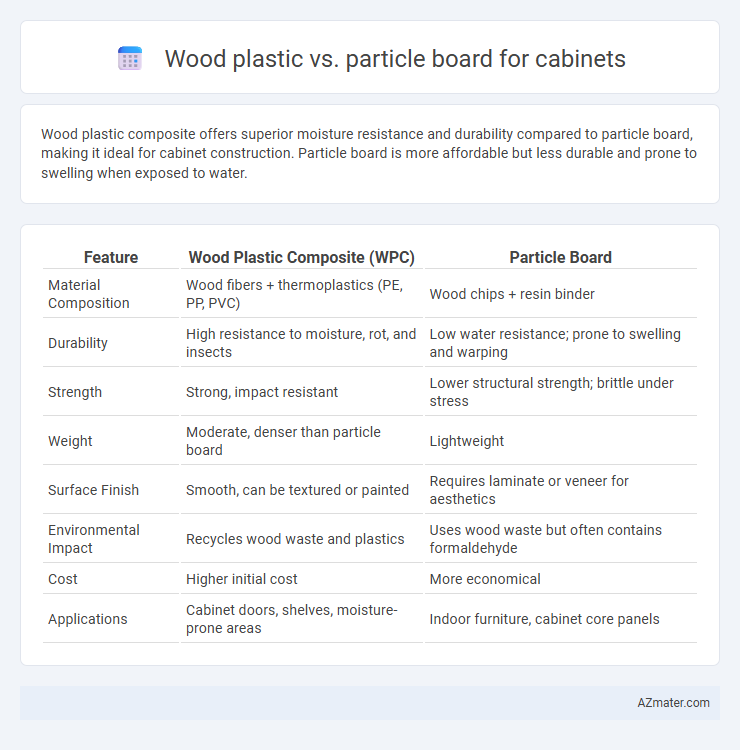Wood plastic composite offers superior moisture resistance and durability compared to particle board, making it ideal for cabinet construction. Particle board is more affordable but less durable and prone to swelling when exposed to water.
Table of Comparison
| Feature | Wood Plastic Composite (WPC) | Particle Board |
|---|---|---|
| Material Composition | Wood fibers + thermoplastics (PE, PP, PVC) | Wood chips + resin binder |
| Durability | High resistance to moisture, rot, and insects | Low water resistance; prone to swelling and warping |
| Strength | Strong, impact resistant | Lower structural strength; brittle under stress |
| Weight | Moderate, denser than particle board | Lightweight |
| Surface Finish | Smooth, can be textured or painted | Requires laminate or veneer for aesthetics |
| Environmental Impact | Recycles wood waste and plastics | Uses wood waste but often contains formaldehyde |
| Cost | Higher initial cost | More economical |
| Applications | Cabinet doors, shelves, moisture-prone areas | Indoor furniture, cabinet core panels |
Introduction to Cabinet Material Choices
Wood plastic composites (WPC) combine natural wood fibers with plastic polymers, offering enhanced durability, moisture resistance, and eco-friendliness, making them a popular choice for modern cabinet construction. Particle board, composed of wood chips and resin, is cost-effective and provides a smooth surface but generally lacks the strength and water resistance of WPC. Selecting between WPC and particle board depends on factors such as budget, durability requirements, and moisture exposure in cabinet applications.
Overview: Wood Plastic Composite Cabinets
Wood plastic composite (WPC) cabinets blend recycled wood fibers and thermoplastic polymers to deliver superior moisture resistance and durability compared to traditional particle board. Engineered for enhanced structural integrity, WPC cabinets exhibit less warping, swelling, and termite susceptibility, ideal for high-humidity environments. Their eco-friendly composition supports sustainable building practices while maintaining aesthetic versatility through various finishes.
Overview: Particle Board Cabinets
Particle board cabinets consist of wood chips, sawdust, and resin compressed into sheets, offering an affordable and eco-friendly option for cabinetry. These cabinets provide a smooth surface ideal for veneers and laminates but are less durable and moisture-resistant compared to wood plastic composites. Commonly used in budget-friendly kitchen or bathroom cabinetry, particle board offers a lightweight solution while requiring careful sealing to prevent swelling and damage from humidity.
Durability Comparison: Wood Plastic vs Particle Board
Wood plastic composite (WPC) cabinets demonstrate superior durability compared to particle board due to their resistance to moisture, swelling, and pest damage, making them ideal for high-humidity environments. Particle board, composed of wood chips and resin, tends to weaken when exposed to water, leading to swelling and reduced structural integrity over time. The enhanced density and polymer composition of WPC provide lasting strength and longevity, significantly outperforming traditional particle board in cabinet applications.
Moisture Resistance: Which Material Performs Better?
Wood plastic composite (WPC) cabinets outperform particle board in moisture resistance due to their synthetic polymer content, which prevents water absorption and swelling. Particle board, made from wood fibers and resin, tends to absorb moisture, leading to warping and deterioration over time. For environments with high humidity or exposure to water, WPC provides a more durable and long-lasting cabinet solution.
Cost Analysis: Affordability and Value
Wood plastic composites generally offer higher durability and moisture resistance at a slightly increased price compared to particle board, making them a valuable investment for long-term cabinet use. Particle board remains the most affordable option, suitable for budget-conscious projects but may require frequent repairs or replacement due to lower durability. Evaluating initial costs against lifespan and maintenance needs is critical for determining the true value of either material in cabinetry applications.
Environmental Impact: Sustainability Factors
Wood plastic composites (WPC) offer a more sustainable choice for cabinets due to their use of recycled plastics and wood fibers, reducing landfill waste and reliance on virgin timber. Particle board, while cost-effective, often involves formaldehyde-based adhesives that can release harmful volatile organic compounds (VOCs) and depends heavily on wood waste, which may not always come from sustainable sources. Choosing WPC improves environmental impact by promoting waste recycling and lowering carbon footprint compared to traditional particle board materials.
Design Flexibility and Aesthetic Appeal
Wood plastic composites offer greater design flexibility for cabinets due to their ability to be easily molded into intricate shapes and smooth finishes, enhancing aesthetic appeal with a modern, uniform look. Particle board provides a budget-friendly alternative but lacks the versatility in design and often requires laminates or veneers to achieve a visually appealing surface. The moisture resistance and durability of wood plastic also contribute to longer-lasting visual quality compared to the more porous particle board.
Maintenance and Longevity Considerations
Wood plastic composite cabinets require minimal maintenance due to their resistance to moisture, pests, and warping, extending their lifespan in humid environments. Particle board cabinets, while cost-effective, are prone to swelling and deterioration when exposed to water, necessitating frequent repairs or replacements. Longevity of wood plastic cabinets can exceed 20 years with proper care, whereas particle board typically lasts 10-15 years under similar conditions.
Which Cabinet Material is Best for You?
Wood plastic composite (WPC) cabinets offer superior moisture resistance and durability compared to particle board, making them ideal for kitchens and bathrooms with high humidity. Particle board cabinets are more affordable but prone to swelling and damage when exposed to water, limiting their lifespan in damp environments. Choosing between WPC and particle board depends on budget constraints and the level of exposure to moisture in the intended installation area.

Infographic: Wood plastic vs Particle board for Cabinet
 azmater.com
azmater.com